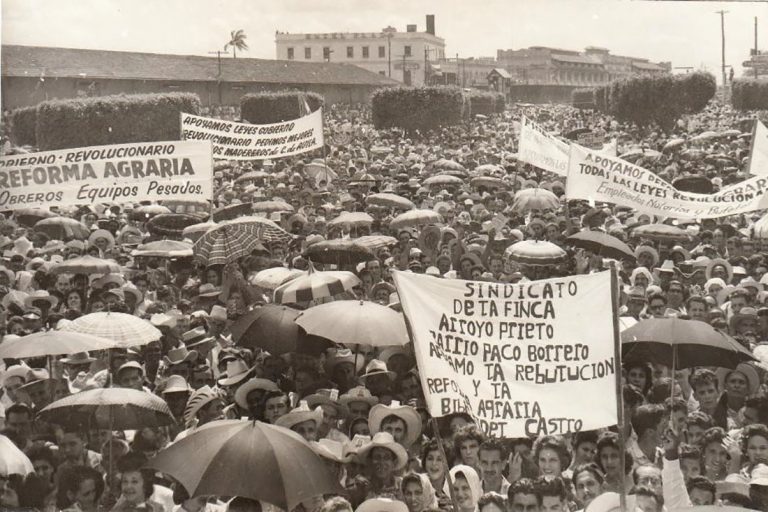After the triumph of the revolution, on January 1st, 1959, the provisional revolutionary government made up of the different forces that had fought against the Batista dictatorship, had to face the difficult social and economic situations accumulated over the years; in a country looted ad nauseam by the governments in power and foreign interests.
The maximum leader of the revolution, Commander Fidel Castro, years before; In the trial of case No. 37 of 1953 for the actions of the assaults on the “Moncada and Carlos Manuel de Céspedes” barracks, in his formidable and historical plea known as “History will absolve me”, he analyzed the agrarian problem of the country.
In it, he referred to the need to apply a law that would grant unattachable and non-transferable ownership of the land to “all settlers, sub-settlers, tenants, sharecroppers and squatters (…)”, since the main causes of Cuba’s agrarian problem were in the unequal ownership of land.
For this reason, the promulgation of an agrarian law dictated by the nascent revolution occupied a permanent point on the agenda of the Council of Minister since Dr. Fidel Castro assumed the position of Prime Minister in February 1959; along with other measures of a social nature, which had not been enacted, in more than a month after the triumph of the Revolution.
From now on, at night a small group made up of Ernesto Guevara, Segundo Ceballos, Oscar Pino Santos, Antonio Núñez Jiménez, Vilma Espín and Alfredo Guevara Valdés met under the direction of Fidel, in Che’s house located at Tarara beach, to draft the bill that would put an end to the landowner regime in Cuba.
The discussions of the articles of the preliminary bill were taken from the minutes presented by Pino Santos and Segundo Ceballos, merged into one by Núñez Jiménez and Che.
In the calendar
The day chosen for its promulgation was May 17th Farmer’s Day, in honor of the farmer Niceto Pérez assassinated in 1946; place, the “Comandancia de la Plata” in the Sierra Maestra.
In the afternoon, the Council of Minister sectioned to ratify the Agrarian Reform Law for the third time; this law should give the country an economic and social order.
The favorable vote of more than two thirds of the council allowed it to be integrated into the Fundamental Law of the Republic. The section appointed Prime Minister Dr. Fidel Castro as president of the National Institute for Agrarian Reform (INRA).
The law was not made in a hurry, not within ten or fifteen days of the revolutionary triumph, but four months and 17 days after it, after extensive debates, after having presented it to the people on the conviction of the essential of passing it and the necessity to contribute financially to it.
The land in the hands of the humble and hardworking men and women
The Agrarian Reform Law was the most transcendental and important of all the laws adopted by the revolution in the early years, it was the law that had the sympathy of the people before being applied, not only for having given the land to one hundred thousand farmers and put an end to the latifundium; but also to free them from the iniquitous exploitation to which they were subjected, bringing well-being to the most suffered and forgotten sector; abandoned through time.
The law, due to its formidable scope and its prospects for Cuba, allowed the country to position itself in the first place in Latin America, in terms of agrarian problems, since its enactment was the first step to get rid of underdevelopment and reach higher standards of living, conscious that with it landowners’ interests were affected, and would generate the natural opposition to a measure of this nature.
In Agramonte’s land
In Camagüey, support for the Agrarian Reform Law was experienced in the months prior to its signing. At the closing of the Provincial Farmer Congress where land problems and the Pro-Agrarian Reform campaign in the region were discussed, the Prime Minister was present.
On April 12th, Fidel would speak to the people of Camagüey in Finlay Park, for which the July 26th movement summoned the people. The Consolidated Railways arranged the departure of trains to make it more viable for the people of Camagüey to attend the great concentration from Nuevitas, Santa Cruz de Sur, Morón and one from Lugareño, free of charge.
In it, Fidel stated “In Camagüey, it is where The Agrarian Reform will be most widely developed … because there is a lot of land that is not in production and because there are many large estates (…)”.
One of the sectors that participated in the event was the railway, with its different communities among them: retirees and pensioners of the Railways, Association of Office Employees, Railway Association of “La Unión” Workshops, United Railways and Workers, Railways Brotherhood of Cuba and “La Unión” Railway Union of Morón.
The railroad workers thus demonstrated their total adherence to the plans and projections of the revolutionary government, at the same time, they donated machinery and agricultural implements to the Agrarian Reform, in support of the economic battle that the country had waged since its beginning.
Translated by: Aileen Álvarez García






